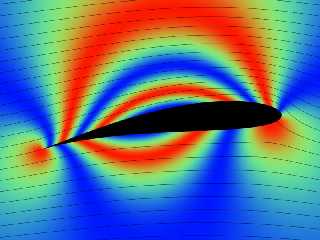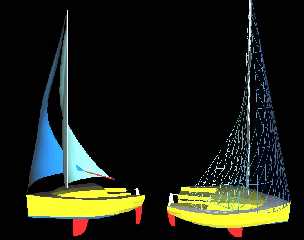 |
 |
|
 |
|
 |
|  |
|  |
|
 |
|
 |
|  |
|  |
|
 |
Just thought it was a result worth sharing. It is NOT CFD; it's just
inviscid potential flow (v=grad(phi) such that div(v)=0) over a CIRCLE with
a center at x=0.1, y=0.1, and through the point x=-1, y=0. There's also
circulation and a flow angle of eight degrees from horizontal. You apply
the conformal map z'=z+1/z (Ewww... complex variables), and you get
potential flow over a Joukowski airfoil. A pretty surprising result,
really. Well I was surprised anyway. The pressure coefficient
distribution is plotted with thousands of tiny spheres since I can't for
the life of me figure out any inverse transformation for the map which
would allow for a function pigment. Sorry for all the nerdspeak.
On a tangent: speaking of CFD, sorry I never got the code for my smoke
(p.b.a, back a couple months or so) simulation posted. My C++ compiler is
broken since I reinstalled. I could post it as-is if there is interest
though.
- Ricky
Post a reply to this message
Attachments:
Download 'cp_airfoil2.jpg' (85 KB)
Preview of image 'cp_airfoil2.jpg'

|
 |
|  |
|  |
|
 |
|
 |
|  |
|  |
|
 |
triple_r wrote:
> Sorry for all the nerdspeak.
>
Hey! That's OK. You're forgiven for a neat pic like that :)
Alf
Post a reply to this message
|
 |
|  |
|  |
|
 |
|
 |
|  |
|  |
|
 |
"triple_r" <nomail@nomail> wrote:
> Just thought it was a result worth sharing. It is NOT CFD; it's just
> inviscid potential flow (v=grad(phi) such that div(v)=0) over a CIRCLE with
> a center at x=0.1, y=0.1, and through the point x=-1, y=0. There's also
> circulation and a flow angle of eight degrees from horizontal. You apply
> the conformal map z'=z+1/z (Ewww... complex variables), and you get
> potential flow over a Joukowski airfoil. A pretty surprising result,
> really. Well I was surprised anyway. The pressure coefficient
> distribution is plotted with thousands of tiny spheres since I can't for
> the life of me figure out any inverse transformation for the map which
> would allow for a function pigment. Sorry for all the nerdspeak.
>
> On a tangent: speaking of CFD, sorry I never got the code for my smoke
> (p.b.a, back a couple months or so) simulation posted. My C++ compiler is
> broken since I reinstalled. I could post it as-is if there is interest
> though.
>
> - Ricky
I like it very much. Some time ago I was trying to simulate behaviour of a
sail in realtime. The image shows what I have ended with. The mathod was
very simple, based on panels and Newton's physics but the results were
quite convincing. I wonder if it is possible to use inviscid potential flow
for such a simulation? Is it fast enought for realtime? I know CFD
certainly is not, but anyway could you post your code for CFD - I'm just
curious how to implement it.
Post a reply to this message
Attachments:
Download 'sailsim.jpg' (73 KB)
Preview of image 'sailsim.jpg'

|
 |
|  |
|  |
|
 |
|
 |
|  |
|  |
|
 |
"Przemek Loesch" <nomail@nomail> wrote:
> I like it very much. Some time ago I was trying to simulate behaviour of a
> sail in realtime. The image shows what I have ended with. The mathod was
> very simple, based on panels and Newton's physics but the results were
> quite convincing. I wonder if it is possible to use inviscid potential flow
> for such a simulation? Is it fast enought for realtime? I know CFD
> certainly is not, but anyway could you post your code for CFD - I'm just
> curious how to implement it.
Looks good. OpenGL? Probably something like Newton's sin^2 theory for lift
applied to cloths? As far as I know that's the best approach to something
like a sail or flag since even an analytic solution for potential flow
around a sail made up of panels would require the solution of a whole lot
of simultaneous equations. The kicker is that analytic solutions like this
only work for steady, inviscid, irrotational flow, so it wouldn't really do
anything interesting. Probably wouldn't be real-time either.
I've been working on a simple fluid simulation over the network using the
school's c++ compiler, so I do have some code I could post with a little
adjustment - I need to put in a better, MUCH more stable method for one
crucial part though. The best part is that it spits out sreamlines and
particles in animated ASCII. I have homework-type stuff to do tonight, but
I'll have some time tomorrow to throw something together. Sorry for more
delay.
- Ricky
Post a reply to this message
|
 |
|  |
|  |
|
 |
|
 |
|  |
|  |
|
 |
"triple_r" <nomail@nomail> wrote:
> Looks good. OpenGL? Probably something like Newton's sin^2 theory for lift
> applied to cloths?
Yes it's OpenGL. Export to POVRay is planned but it is not ready yet. The
"physical" solution is very ugly. Forces on the panels are calculated by
dotproducts of normal vectors and wind vectors. Then wind direction is
corrected for every panel by considering influence of the neigbours. On the
other hand panels are represented by point masses connected by springs. The
last step of simulation is a kind of inverse kinematics step to examine if
the points are not too far from each other and to make the sail less
rubber. I have many empirical coefficients and this is far from being pure
physical solution.
> The kicker is that analytic solutions like this
> only work for steady, inviscid, irrotational flow, so it wouldn't really do
> anything interesting. Probably wouldn't be real-time either.
It's a pity.
> I've been working on a simple fluid simulation over the network using the
> school's c++ compiler, so I do have some code I could post with a little
> adjustment - I need to put in a better, MUCH more stable method for one
> crucial part though. The best part is that it spits out sreamlines and
> particles in animated ASCII. I have homework-type stuff to do tonight, but
> I'll have some time tomorrow to throw something together. Sorry for more
> delay.
Take it easy Ricky. I'm just always curious to see how physical equations
are implemented in code. There is no hurry.
Przemek
Post a reply to this message
|
 |
|  |
|  |
|
 |
|
 |
|  |
|  |
|
 |
"triple_r" <nomail@nomail> wrote:
> Looks good. OpenGL? Probably something like Newton's sin^2 theory for lift
> applied to cloths?
Yes it's OpenGL. Export to POVRay is planned but it is not ready yet. The
"physical" solution is very ugly. Forces on the panels are calculated by
dotproducts of normal vectors and wind vectors. Then wind direction is
corrected for every panel by considering influence of the neigbours. On the
other hand panels are represented by point masses connected by springs. The
last step of simulation is a kind of inverse kinematics step to examine if
the points are not too far from each other and to make the sail less
rubber. I have many empirical coefficients and this is far from being pure
physical solution.
> The kicker is that analytic solutions like this
> only work for steady, inviscid, irrotational flow, so it wouldn't really do
> anything interesting. Probably wouldn't be real-time either.
It's a pity.
> I've been working on a simple fluid simulation over the network using the
> school's c++ compiler, so I do have some code I could post with a little
> adjustment - I need to put in a better, MUCH more stable method for one
> crucial part though. The best part is that it spits out sreamlines and
> particles in animated ASCII. I have homework-type stuff to do tonight, but
> I'll have some time tomorrow to throw something together. Sorry for more
> delay.
Take it easy Ricky. I'm just always curious to see how physical equations
are implemented in code. There is no hurry.
Przemek
Post a reply to this message
|
 |
|  |
|  |
|
 |
|
 |
|  |




![]()